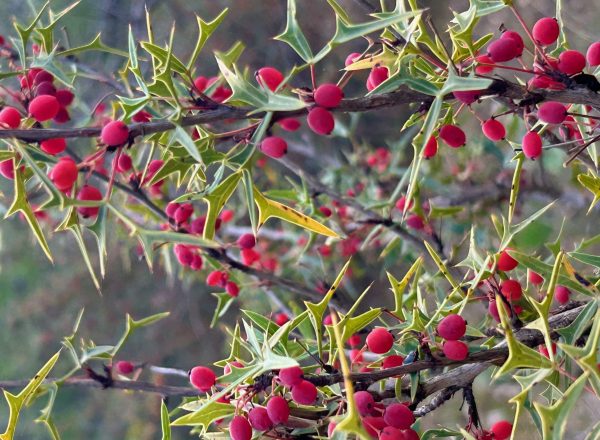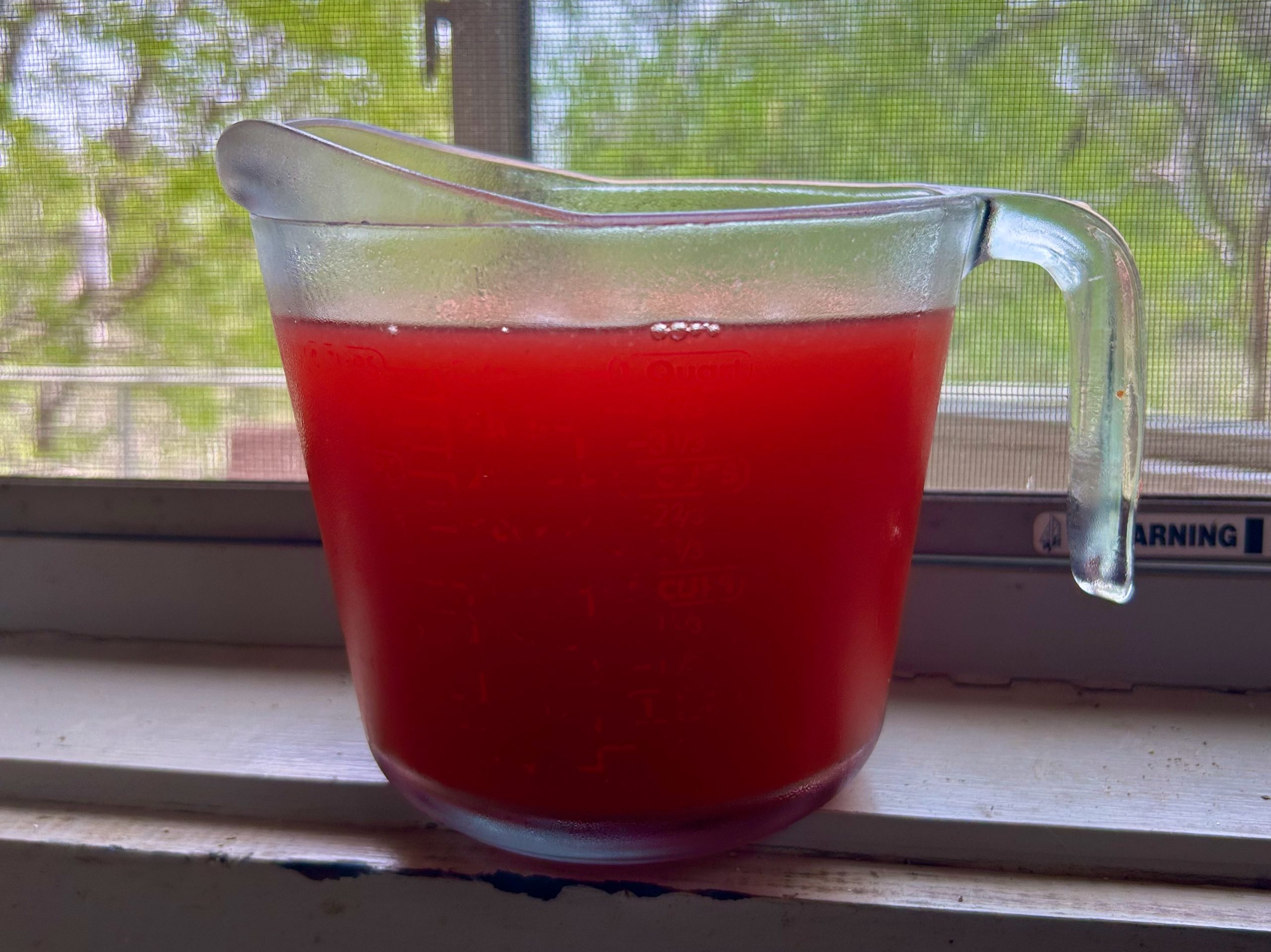After several years of sparse output, Texas Hill Country agarita bushes are having a banner berry season.
The fruit of the most common species of barberry found in Texas are ubiquitous in parts of the Texas Hill Country right now. They look like small currents. The bush forms thickets and its fragrant, yellow flowers are among the first blooms to appear each season, usually in February. Red berries follow in April and continue ripening into June.
Describing 2023’s massive agarita output as “gangbuster,” Andrea DeLong-Amaya, Director of Horticulture at the Ladybird Johnson Wildflower Center in Austin, explained that plants have good and bad years.
“If they were hit with something last year, they’ll make up for it the following one if conditions are right,” she said.
Foraging expert Mark “Merriwether” Vorderbruggen agreed that favorable timing and weather conditions played a role in this year’s large agarita crop.
“The combo of drought followed by a fair amount of rain can trigger plants to produce excess fruit. It’s a stress response, like, ‘I might be in ‘danger, so I better produce a lot,'” said Merriweather, a PhD in chemistry, author, and creator of the popular Foraging Texas website. He suggested the Texas grape season this year might also be especially robust.
Hill Country agarita fans have noticed the berry bounty.

This year’s “gangbuster” agarita crop can be attributed to timely rains and favorable temperatures. –Photo by Monika Maeckle
“The most I have seen in 13 years here!” Gerald T. Bohmfalk shared on the Mason County Community Facebook page. Lynn Sample noted that on the north side of Fredericksburg, her agarita bushes were “loaded.”
“They’re everywhere,” said Ann Newman of San Antonio.
From the kitchen window of her family’s Vanderpool ranch house, Newman watched an oriole make multiple trips to an agarita bush to retrieve single berries to feed her clutch of four chicks. She said the contrast of the bright yellow-and-black bird holding the ruby red berries in her mouth was a striking sight and that over the course of her family’s several-day visit, the oriole “must have made a hundred trips” to the agarita bush.
Songbirds thrive on agarita berries, as do quail and small mammals, yet deer leave it alone–probably because they can’t access the berries without getting stabbed by the thorny, five-pronged leaves. Some animals use the stickery shrubs for protective cover; others, as an opportunistic hunting blind.
Beryl Armstrong, a conservation land manager, and co-owner and founder of Plateau Land Management, recalled a Hill Country saying repeated to him over the years.
“To harvest agarita, all you need is a broom, a sheet and a shotgun.” The broom is to beat the bushes and knock the berries off, the sheet is to catch the harvest, and the shotgun is to shoot the snake waiting under the thorny stems.
“Snakes are opportunistic predators and they’ll hang out wherever the prey is going to be–in blackberry brambles, fruit bushes and agarita shrubs,” said Armstrong.
NOTE: As a wildlife conservationist, Armstrong does not condone the shooting of snakes, which serve important roles in the ecosystem. “Most snake bites are caused by human foolishness,” he said.
Armstrong agreed that the berry bounty results from good timing and weather conditions, what is known as phenology, in science. Last year we had almost no agarita berries because of the late freezes, he explained, while this year we avoided a hard, late freeze. “The flowers came out early and abundant and we got some intermittent rain. The agarita got busy and made babies this year.”
Agarita’s defensive prowess and multiple uses are legendary. Foragers use agarita berries in tarts, pancakes, and cobblers or convert them into jelly, syrup, juice, and compotes.
Wildlife also consume the berries, which are loaded with pectin, carbohydrates, Vitamin C, and antioxidants. Vorderbruggen’s Foraging Texas website cites agarita’s many uses. Its plentiful seeds can be roasted and ground for a caffeine-free coffee substitute. Other ethnobotanical sources praise agarita’s utility: its leaves can be chewed to prevent nausea, wood can be boiled to make dyes, and roots utilized to fight fungi and bacterial infections.
Vorderbruggen mentioned that agarita’s bright, orange-colored wood is filled with berberine, a bittering agent that can be made into a bitters-like syrup, perfect for cocktails. “I’ve heard of people making swizzle sticks out of agarita twigs–just remove the bark,” he said.
Unfortunately, agarita is not widely available in nurseries. If you find yourself smitten with this plant, you’ll have to check out native plant sales, shop at specialty nurseries, grow it from seed or transplant from the wild.
According to How to Grow Native Plants of Texas and the Southwest, growing agarita from seed takes three years to produce a five-gallon plant. Fruit will follow, but the timing of that is unpredictable, and depends largely on light, temperature and water. Well-drained soil is a must. Seeds are available online, but be sure to get Mahonia trifoliata.
Agarita’s spiny leaves make gathering its fruits a literal pain.

Agarita juice: use it for a spritzer, drink it straight, or how about an Agarita-rita? –Photo by Monika Maeckle
The classic harvesting approach is to lay a sheet on the ground and beat the bush with a stick or broom. An umbrella under a branch flush with berries also works, as you comb the spindly ream, from the inside of the bush out, since the prickly leaves face outward. Wear protective, elbow-length gloves.
Inevitably, twigs, agarita leaves, dirt, organic matter, and numerous insects will accompany your berry harvest. Once you have your bowl of berries, pick out the detritus.
Piling a cup or so of berries on a small mesh screen while tilting and shaking slightly also can serve to separate the fruit from the chaff.
You can also put the uncleaned berries on a mesh screen and hold it over a leaf blower or in front of a fan, which effectively clears the detritus.
TOP PICTURE: Agarita berries, fresh from the bush. –Photo by Monika Maeckle
Related posts:
- Votes are in! Mealy blue sage wins 2023 Unofficial Pollinator Plant of the Year
- How to plan a successful butterfly garden
- Leverage summer heat and convert water guzzling turf to pollinator habitat
- Mostly native butterfly garden outperforms lawn every time
- A year in the life of an urban butterfly garden
- Downtown River walk plot converts to pollinator garden, creature haven
- Converting your Lawn to a Butterfly Garden
- San Antonio becomes first National Wildlife Federation Monarch Champion city
- Tropical Milkweed: To Plant it or Not is Not a Simple Question
Like what you’re reading? Don’t miss a single post from the Texas Butterfly Ranch. Sign up for email delivery, like us on Facebook, or follow us on Twitter, @monikam.


Love this…. I have ten butterfly plants but no Monarchs. Is it too early?
Monika,
This is a really good article with great photos. Thank you for your efforts to describe what is happening with the Agarlita berry this year. We are having a very good year with our Antelope horn milkweed seed pods this year.
Byron Augustin
Great article Monika! I’m excited to join you for Agarita harvesting !!